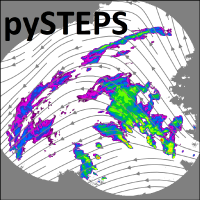pysteps.tracking.lucaskanade.track_features
pysteps.tracking.lucaskanade.track_features¶
- pysteps.tracking.lucaskanade.track_features(prvs_image, next_image, points, winsize=(50, 50), nr_levels=3, criteria=(3, 10, 0), flags=0, min_eig_thr=0.0001, verbose=False)¶
Interface to the OpenCV Lucas-Kanade feature tracking algorithm (cv.calcOpticalFlowPyrLK).
- Parameters
- prvs_image: ndarray_ or MaskedArray_
Array of shape (m, n) containing the first image. Invalid values (Nans or infs) are replaced with the min value.
- next_image: ndarray_ or MaskedArray_
Array of shape (m, n) containing the successive image. Invalid values (Nans or infs) are replaced with the min value.
- points: array_like
Array of shape (p, 2) indicating the pixel coordinates of the tracking points (corners).
- winsize: tuple of int, optional
The winSize parameter in calcOpticalFlowPyrLK. It represents the size of the search window that it is used at each pyramid level. The default is (50, 50).
- nr_levels: int, optional
The maxLevel parameter in calcOpticalFlowPyrLK. It represents the 0-based maximal pyramid level number. The default is 3.
- criteria: tuple of int, optional
The TermCriteria parameter in calcOpticalFlowPyrLK , which specifies the termination criteria of the iterative search algorithm. The default is (3, 10, 0).
- flags: int, optional
Operation flags, see documentation calcOpticalFlowPyrLK. The default is 0.
- min_eig_thr: float, optional
The minEigThreshold parameter in calcOpticalFlowPyrLK. The default is 1e-4.
- verbose: bool, optional
Print the number of vectors that have been found. The default is False.
- Returns
Notes
The tracking points can be obtained with the
pysteps.utils.images.ShiTomasi_detection()routine.References
Bouguet, J.-Y.: Pyramidal implementation of the affine Lucas Kanade feature tracker description of the algorithm, Intel Corp., 5, 4, 2001
Lucas, B. D. and Kanade, T.: An iterative image registration technique with an application to stereo vision, in: Proceedings of the 1981 DARPA Imaging Understanding Workshop, pp. 121–130, 1981.
